Greater Painted-snipe🠉
Rostrula benghalensis
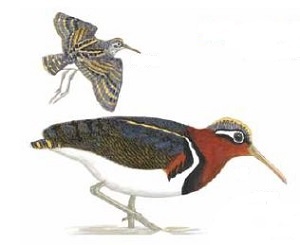
This snipe resembles the Common Snipe, but is heavier in flight and has broad rounded wings. The legs are long and the feet project beyond the tail. Bill fairly short, deep, very slightly curved, and pale flesh-coloured. A pair of “braces” are visible along the sides of the mantle. Belly uniform white. Narrow pale stripe along the top of the head. Broad pale eye-ring, which extends in a line behind the eye. Underwing white in the centre contrasting with dark edges.
Adult male: duller than the female, with the head and neck grey-brown streaked whitish. Supercilium buffish. Wing coverts with broad transverse buff-brown markings.
Adult female: throat, neck, and upper chest brown-red bordered with a wide dark line on the chest. Crown greenish-brown. Eye ring and supercilium white. Upperparts and upperwings bright green.
Juvenile: like the adult male, but chest with small, less distinct markings, and no sharp contrast with the belly. The upperside is heavily pale-barred.
Voice: the females produce a muffled “kou-out”.
L. 23-26 cm ; W. ?
Similar species: Common Snipe, Great Snipe, Jack Snipe.
©Serge Nicolle
Oystercatcher🠉
Haematopus ostralegus
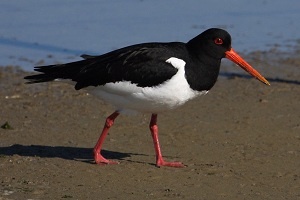
Large, stocky, deep-chested wader, distinguished by its long straight orange-red bill, and its black-and-white plumage. The legs vary from fleshy-coloured in adults to greyish in juveniles. The black colour is tinged with brownish in sub-adults and juveniles. Seen at the coast.
Call: loud high-pitched “beek” or “bteek”.
L. 39-44 cm ; W. 72-83 cm.
Similar species : Any in the area.
©Thomas Galewski
Black-winged Stilt🠉
Himantopus himantopus
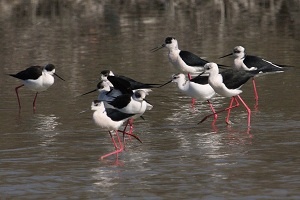
Distinctive shape, with very long, red or (in immatures) red-brown legs, and a long, straight, needle-thin black bill. The plumage in adults is black (with a green gloss), and white. Duller, finely scaled in immatures, which also show a pale trailing edge to the wing. The narrow, pointed black wings contrasting with the white body, and the very long red legs, create a distinctive impression in flight. Usual call a noisy, repeated “kyik-kyik-kyik”.
L. 33-36 cm ; W. 67-83 cm.
Similar species : Any in the area.
©Thomas Galewski
Pied Avocet 🠉
Recurvirostra avosetta
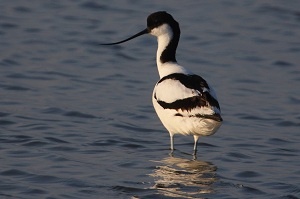
Large, unmistakeable wader: distinctive thin, black, upturned bill. Black-and-white plumage with pale blue legs. Immatures have brown markings on the upperparts and nape. Feeds mostly by moving the head from side to side in the water.
Call: whistled, piping “plit-plit-plit”.
L. 42-46 cm ; W. 67-77 cm.
Similar species : Any in the area.
©Thomas Galewski
Crab Plover🠉
Dromas ardeola
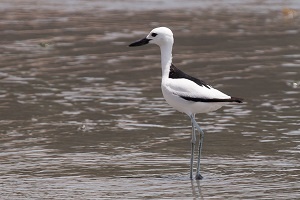
Distinctive: large, with black-and-white plumage. Has a disproportionately big, straight, dagger-shaped black bill. The legs are long, blue-grey coloured. In flight, strong contrast between the blackish remiges, primary coverts, and greater coverts, black back, and white remainder of plumage. The juvenile is dark on top of the head and on the nape, and grey on the upperparts.
Voice: a range of metallic calls including “kwaa-daa-dak” and “kwaa-daa”.
L. 38-41 cm ; W. 75-78 cm.
Similar species : Any in the area.
©Frédéric Pelsy






